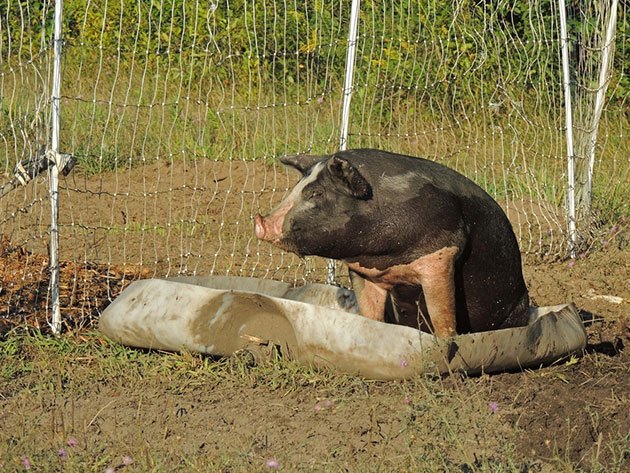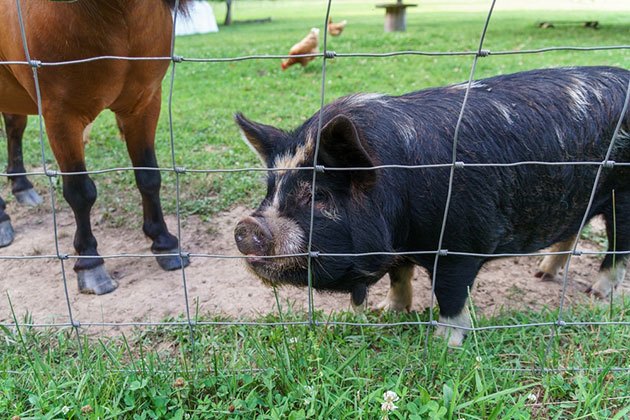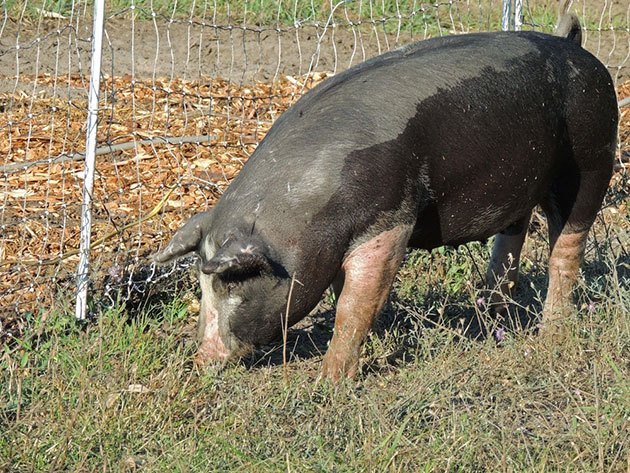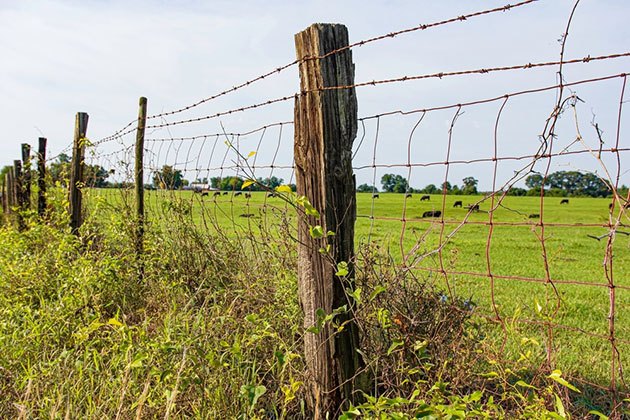Did someone tell you before that pigs and hogs cannot be confined with an electric fence?
Yet, we frequently hear these claims that electric fencing is not a proper choice due to the stubborn nature of the hogs.
You should be relieved to know that these animals can easily be contained!
With proper training and a well-built fence with adequate materials, your hogs will be safely secured in their area.
Choosing the correct electric fence for hogs can be challenging. For example, should you put up a permanent post, or should you opt for a temporary one for grazing purposes?
Time to learn about the practical solutions you can do for electric hog fencing.
About Hogs: Get to Know Their Social Behavior

A hog is a mature swine weighing over 120 pounds.
Since many relate hogs and pigs to be the same, you should know about the fundamental difference. Specifically, a pig is a young, not yet mature swine.
They are highly intelligent animals with developed social behavior.
With diet, hogs are mainly omnivores, mainly plant-based animals. They also tend to fill in their diet with invertebrate animals such as worms, reptiles, insects, etc.
For this reason, you must build an adequate system that will allow hogs to graze freely.
Acorns are a big part of their feeding chain, and it can be a good idea to install electric fencing below acorn trees if possible.
The short-haired animal has an acute sense of smell. As a result, they can easily discriminate between familiar and unfamiliar territory and pigs.
Additionally, hogs are known for their digging skills.
Farmers usually opt for electric fencing to prevent the digging habit of hogs.
However, if they sense underground food, nothing will stop a hog from creating a hole unless it involves mild electric shocks, of course.
For instance, a sow often uses its snout to dig out truffles. In addition, hogs naturally inhabit a large brain and are known to be one of the most intelligent domesticated animals.
Once they have been trained to obey, a hog will remember that experience and acquire new ones with ease.
Therefore, these animals are extremely easy to control with electric fencing.
Hogs & Electric Fencing: Friends or Enemies?
Can you train hogs to stay within the perimeters of the fence? Hogs are complex creatures yet quite smart and can easily be trained.
Most hogs and pigs see fences as an invitation to scratch, push, lean on, rub on and entirely destroy until they knock over all the posts.
However, with electric fences, this is not possible!
When you are raising pigs, you need to train them to respect the fence’s boundaries from a young age.
Have small piglets contained with a regular non-electric fence, to begin with. In this way, they will not be traumatized by the electrical voltage but will learn to respect it.
Once the piglets have begun to feel comfortable around the estate, it’s time to train them with electrical fencing.
Built a double-strand pig fence so they can be fully aware there is a dangerous barrier.
The fence set up for hogs, pigs, sheep, and poultry is a wonder. It teaches them not only of a physical barrier but of a metal one as well.
The effectiveness of the training is seen relatively soon, as the animal quickly acquires the knowledge there is a boundary line.

Why Should You Install an Electric Fencing for Pigs & Hogs?
- The system can be installed as a portable electric fence, enabling relocation. It’s specifically beneficial for strip and rotational grazing.
- Compared with a regular hog pen and panels, installing an electric fence is cheaper.
- It keeps the hogs safe from other feral pigs and wild boars that may try to invade their space.
- You can reinforce the safety system of your existing non-electrical fence.
- Prevent the contact of free-range pigs with wild boars. Additionally, contaminated free-range meat increases the risk of swine fever.
What Is the Best Electric Fencing for Hogs?
Free-range pigs and hogs will require a particular fencing system.
If you decide on using electric netting, you should adjust the design of it to fit the body measurements of hogs.
For instance, post-electric netting too high will give young piglets enough freedom to slide right below the fence.
Also, if the fence line is too low to the ground, they can quickly leap over it.
So, what’s the best solution in this case?
If you don’t want to risk hogs escaping away, the most reliable solution would be to install a three-strand fence wire at four, eight, twelve, and sixteen inches from the ground. It’s sufficient to hold a hog of any size and will set a trap for any other intruders.
Plus, it’s the best solution for dry areas and rocky terrain.
Or, you can also install a single strand of fence wire just at the snout area.
It will give them a mid electricity shock to prevent an escape. However, it’s not the most reliable solution for untrained hogs.
A poly electric wire is the easiest one to set up. If you plan on relocating the fence, a poly wire allows you to install it on a temporary fence.
It’s best for grazing purposes; plus, the rope stays tight with tension.
Electric Fencing Supplies
To build a safe electric fence, you will need the following electric fencing supplies:
- Fence of choice (poly wires, steel wires, poly tape, or mesh panels.)
- Energizer
- Electric source (electric or solar)
- Fence posts
- Gate handles
How to Set Up the Fence Wire?

When setting up a pig fence for hogs or even free-range pigs, you need to consider the wire height.
The rest is easily managed, but the height will offer the minimum protection for starters.
A basic rule of thumb is using two strands or three for bigger hogs.
We mentioned the placement of the wires previously. One wire should be at least at 4” of the ground while the last upper wire needs to reach at least 16 or 24”.
As far as the installation of the wires goes, you can opt for metal T-posts. The poly wire is easily connected to the line of the t-post.
However, if you plan on installing the fence on rocky terrain with uneven surfaces, you will probably need permanent posts.
To safely contain hogs, you will need a proper electric charger.
We advise you to go with Zareba as it is a low-impendence charger with a minimum of 2,000 volts.
Clear the Fencing Area
When installing a pig fence, it’s necessary to clear out the area around it. This includes getting rid of heavy weeds or tall grass and debris.
Then, they can significantly decrease the power conveyed through the fence.
It would be best if you avoided rough terrain and trees. Although wood is a poor voltage conductor, it can still catch on to the current and disrupt the energy.
Even the smallest weeds around the fence can drastically change your fence’s effectiveness.
Additionally, it would help if you also thought about the condition of the ground.
Whether the ground is wet or dry can also affect the fence. The wetter the land is, the better shock it will offer.
Chargers & Voltage
Fencing is a wise investment for many farm owners. But, learning about the proper voltage and charge of the fence is crucial.
With a pig fence, you will need to use an energizer that produces a minimum of 2.5 joules, but you can also go higher.
You will probably need more wires, netting, and more than one energizer if you have a larger ground area.
For instance, if you have around 20 acres of fencing, creating a strong fence will require at least 15 jouls energizers.
We recommend you opt for a low-impedance charger as far as the charger goes. Behind every quality pig fence lies a strong ground and a powerful energizer!
Low impedance chargers are the best ones for hogs.
They deliver short pulses that are better for these short-haired animals.
However, a charger can be only as strong as the ground system, and the following equipment is.
Without proper posts, wires/netting, and grounding, an energizer can only do the minimum work.
Maintenance of the Fence

A fence for pigs and hogs is not the world’s most affordable investment. Therefore, you will need to maintain the fence once in a while.
You can do this via a voltage meter to ensure the electrical circuit delivers its best.
Additionally, directional finders are also beneficial. They detect low and short energy circuits. If needed, cut down the heavy vegetation and weeds around the fence.
If your area is often visited with unstable weather, purchase a lightning protection system. This is especially recommended to owners who use joined electricity to the barn and house.
Even the energizer, a fence, can act as a direct route to the lightning.
Conclusion
Although it’s often looked down on, electric fence for hogs proves to be the most beneficial safety system.
With proper training, pigs and hogs obey the fence’s boundaries and will not try to plan an escape.
You can still allow the hogs to enjoy grazing if you opt for temporary fences.
Nonetheless, electric fences will also stop wild boars from entering and the development of swine fever.
